Improving the Efficiency of Electrical Discharge Machining of Special-Purpose Products with Composite Electrode Tools
Abstract
:1. Introduction
Related Work
2. Materials and Methods
2.1. Materials
2.2. Temperature Simulation
2.3. Experimental Work
3. Results
3.1. Factor Planning Results
3.2. Comparison of Experimental Results and Theoretical Model
4. Conclusions
Author Contributions
Funding
Institutional Review Board Statement
Informed Consent Statement
Data Availability Statement
Conflicts of Interest
References
- Panner Selvam, M.; Ranjith Kumar, P. Optimization kerf width and surface roughness in wirecut electrical discharge machining using brass wire. Mech. Mech. Eng. 2017, 21, 37–55. [Google Scholar]
- Anandakumar, P.; Molla, B.; Biruke, F.; Aravind, S. Analysis of copper mixed kerosene servotherm in EDM of Monel 400™. IOP Conf. Ser. Mater. Sci. Eng. 2017, 197, 012004. [Google Scholar] [CrossRef]
- Arrazola, P.J.; Garay, A.; Iriarte, L.-M.; Armendia, M.; Marya, S.; Le Maître, F. Machinability of titanium alloys (Ti6Al4V and Ti555.3). J. Mater. Process. Technol. 2009, 209, 2223–2230. [Google Scholar] [CrossRef] [Green Version]
- Gibson, R.F. A review of recent research on mechanics of multifunctional composite materials and structures. Compos. Struct. 2010, 92, 2793–2810. [Google Scholar] [CrossRef]
- Hamzah, C.M.; Kasim, M.S.; Mohamad, E.; Sulaiman, M.A.; Ito, T. Study on cutting parameter on kerf width using wire electrical discharge machining of Inconel 718. In Proceedings of the 24th Design Engineering Systems Division JSME Conference, Tokushima, Japan, 17–19 September 2014; pp. 14–27. [Google Scholar]
- Maher, I.; Ling, L.H.; Sarhan, A.A.; Hamdi, M. Improve wire EDM performance at different machining parameters - ANFIS modeling. IFAC-Pap. OnLine 2015, 48, 105–110. [Google Scholar] [CrossRef]
- Hayakawa, S.; Sasaki, Y.N.; Itoigawa, F.; Nakamura, T. Relationship between Occurrence of Material Removal and Bubble Expansion in Electrical Discharge Machining. Procedia CIRP 2013, 6, 174–179. [Google Scholar] [CrossRef] [Green Version]
- Kinoshita, N.; Fukui, M.; Kimura, Y. Study on Wire-EDM: Inprocess Measurement of Mechanical Behaviour of Electrode-Wire. CIRP Ann. 1984, 33, 89–92. [Google Scholar] [CrossRef]
- Chattopadhyay, K.; Verma, S.; Satsangi, P.; Sharma, P. Development of empirical model for different process parameters during rotary electrical discharge machining of copper-steel (EN-8) system. J. Mater. Process. Technol. 2009, 209, 1454–1465. [Google Scholar] [CrossRef]
- Das, S.; Klotz, M.; Klocke, F. EDM simulation: Finite element-based calculation of deformation, microstructure and residual stresses. J. Mater. Process. Technol. 2003, 142, 434–451. [Google Scholar] [CrossRef]
- Peng, Z.L.; Li, Y.N.; Fang, D.; Zhang, Y.Y. Micro electrical discharge machining single discharge temperature field simulation. J. Chem. Pharm. Res. 2013, 5, 859–864. [Google Scholar]
- Tang, J.; Yang, X. A Thermo-hydraulic Modeling for the Formation Process of the Discharge Crater in EDM. Procedia CIRP 2016, 42, 685–690. [Google Scholar] [CrossRef]
- Maradia, U. Meso—Micro EDM. Ph.D. Thesis, ETH Zurich, Zürich, Switzerland, 2014; p. 246. [Google Scholar] [CrossRef]
- Pisarciuc, C. A review of unconventional procedures for manufacturing tool electrodes used in EDM. Rom. Recent 2014, 15, 205–209. [Google Scholar]
- Gu, L.; Farhadi, A.; Zhu, Y.; He, G.; Zhao, W.; Rajurkar, K. A novel tool design procedure for arc sweep machining technology. Mater. Manuf. Process. 2020, 35, 113–121. [Google Scholar] [CrossRef]
- Mayer, H.; Schuller, R.; Karr, U.; Irrasch, D.; Fitzka, M.; Hahn, M.; Bacher-Höchst, M. Cyclic torsion very high cycle fatigue of VDSiCr spring steel at different load ratios. Int. J. Fatigue 2015, 70, 322–327. [Google Scholar] [CrossRef]
- Tovo, R.; Lazzarin, P.; Berto, F.; Cova, M.; Maggiolini, E. Experimental investigation of the multiaxial fatigue strength of ductile cast iron. Theor. Appl. Fract. Mech. 2014, 73, 60–67. [Google Scholar] [CrossRef]
- Tao, J.; Ni, J.; Shih, A.J. Modeling of the Anode Crater Formation in Electrical Discharge Machining. J. Manuf. Sci. Eng. 2012, 134, 011002. [Google Scholar] [CrossRef] [Green Version]
- Liao, Y.; Wu, P.; Liang, F. Study of Debris Exclusion Effect in Linear Motor Equipped Die-sinking EDM Process. Procedia CIRP 2013, 6, 123–128. [Google Scholar] [CrossRef] [Green Version]
- Yeo, S.H.; Kurnia, W.; Tan, P.C. Electro-thermal modelling of anode and cathode in micro-EDM. J. Phys. D Appl. Phys. 2007, 40, 2513–2521. [Google Scholar] [CrossRef]
- Dewangan, S.; Biswas, C.K. Optimisation of machining parameters using grey relation analysis for EDM with impulse flushing. Int. J. Mechatron. Manuf. Syst. 2013, 6, 144–158. [Google Scholar] [CrossRef]
- Balleys, F.; Piantchenko, C. Surface integrity of materials machined by wire EDM machines. EDM Technol. Transf. 1996, 4, 3–6. [Google Scholar]
- Kobayashi, K. The present and future technological developments of EDM and ECM. In Proceedings of the 11th International Symposium for Electromachining (ISEM-11), Lausanne, Switzerland, 17–21 April 1995; pp. 29–47. [Google Scholar]
- Szczesniak, S. Anti-electrolysis is pro EDM. Mod. Mach. Shop 1998, 70, 70–74. [Google Scholar]
- Schneider, A.; Hommel, G.; Blettner, M. Linear Regression Analysis: Part 14 of a Series on Evaluation of Scientific Publications. Dtsch. Aerzteblatt Online 2010, 107, 776–782. [Google Scholar]
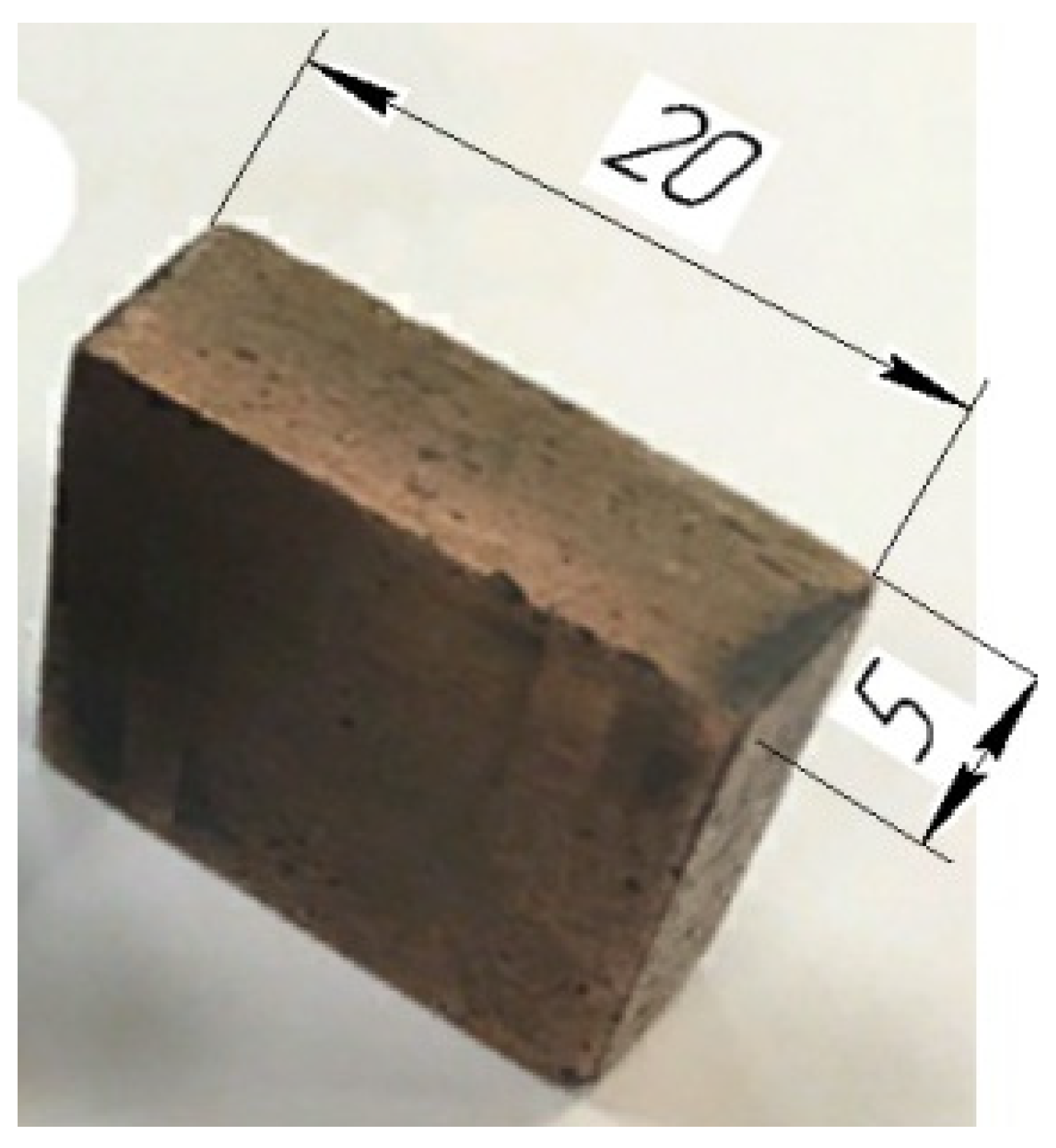
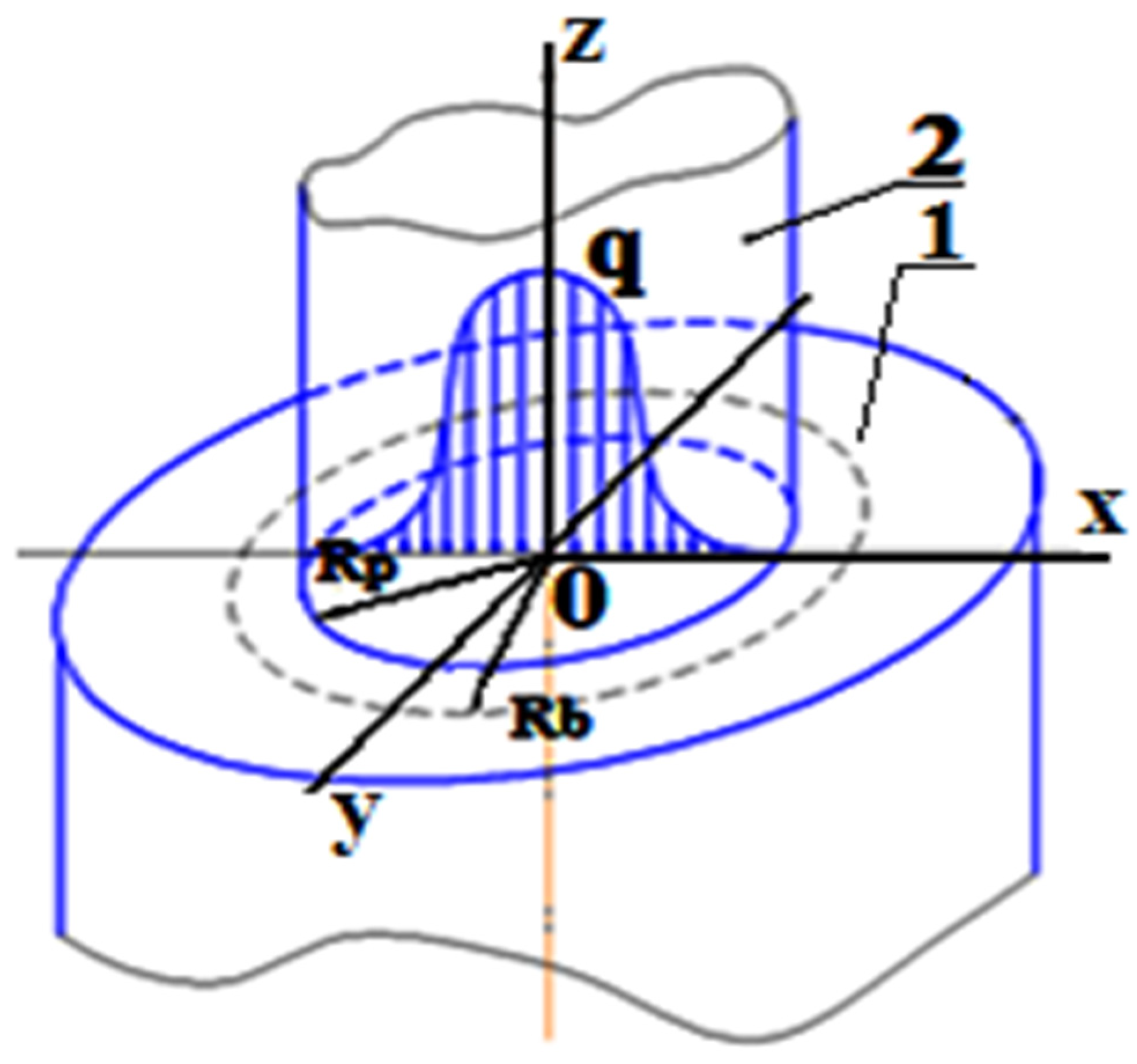

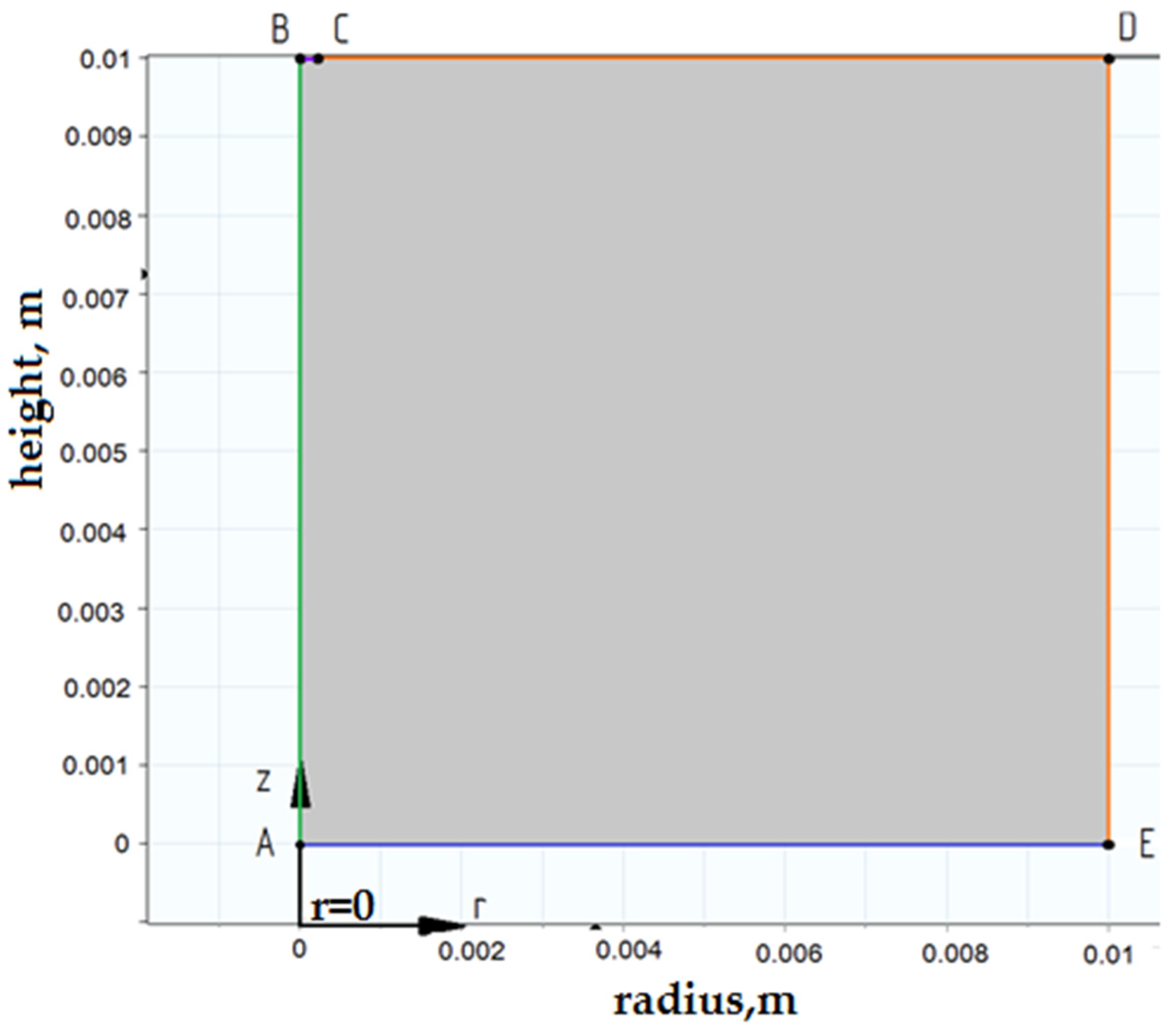
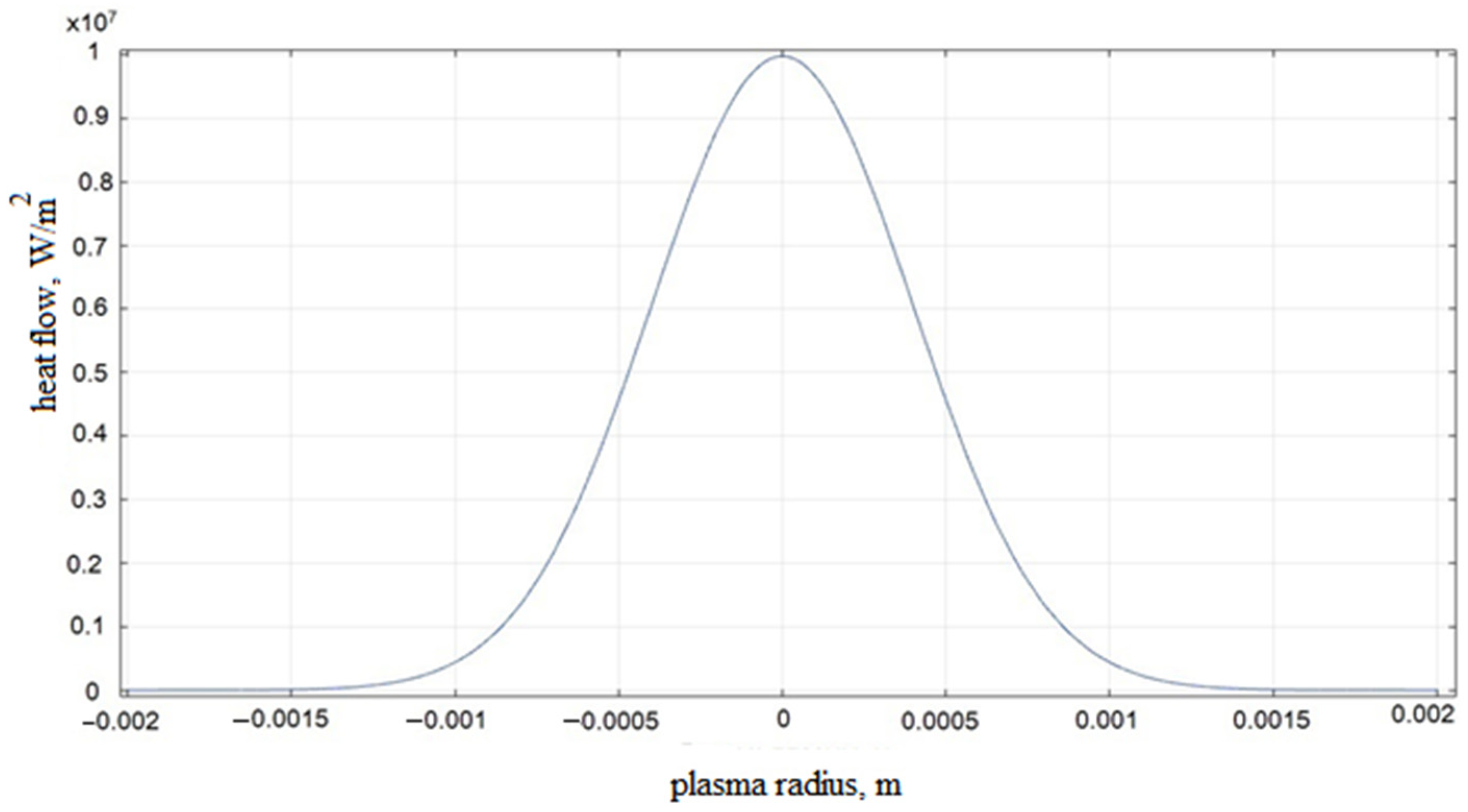
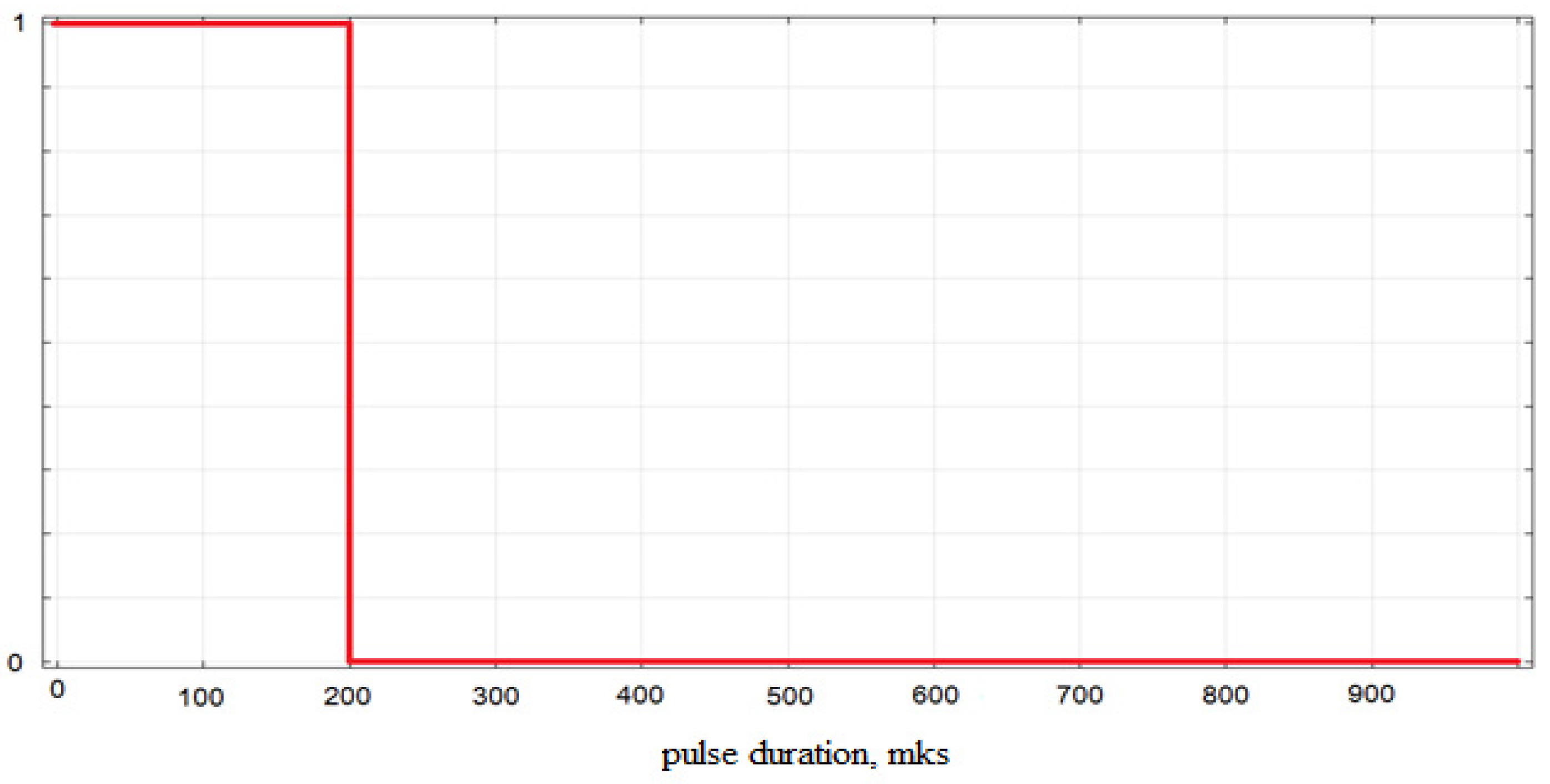
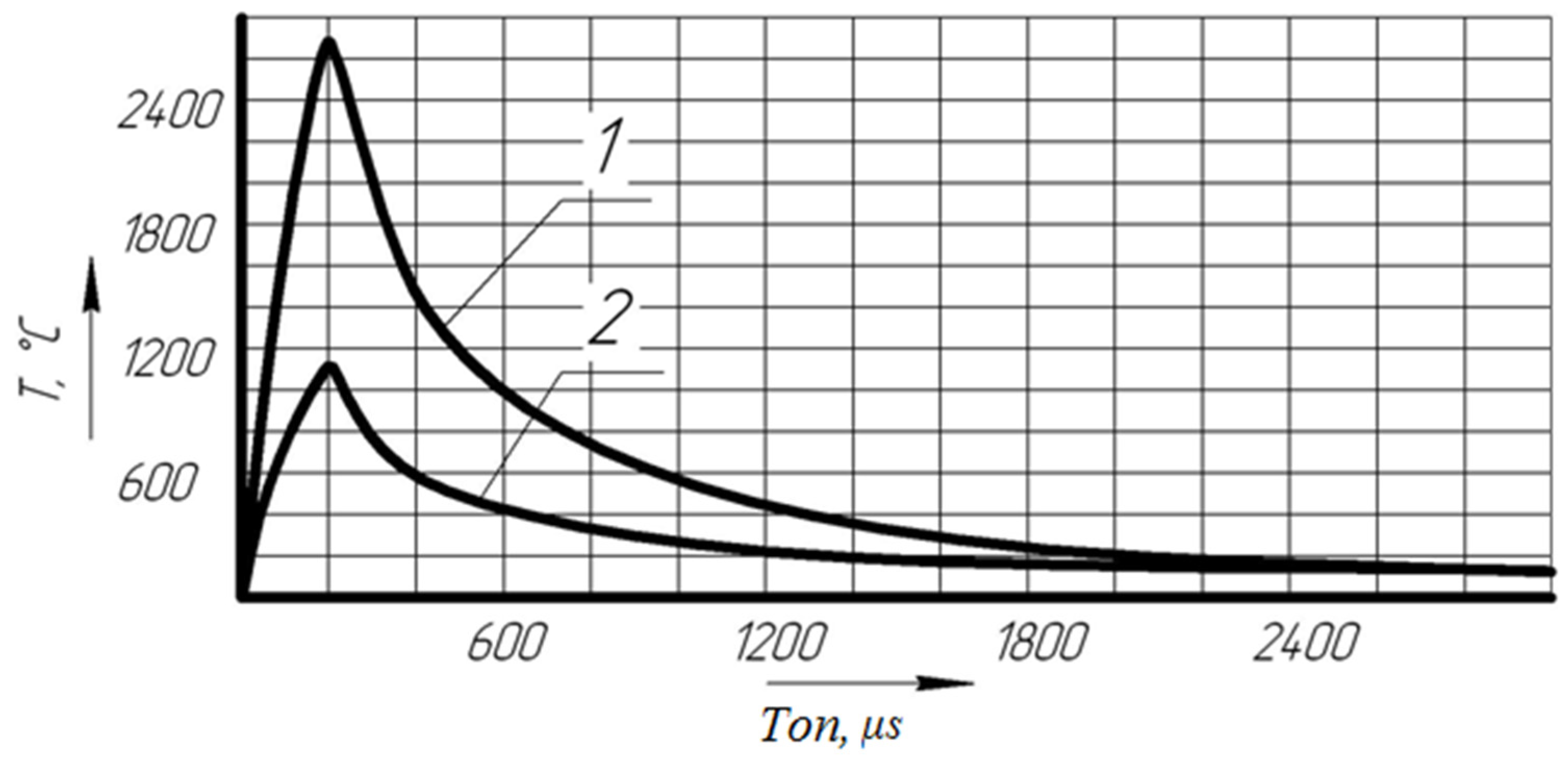
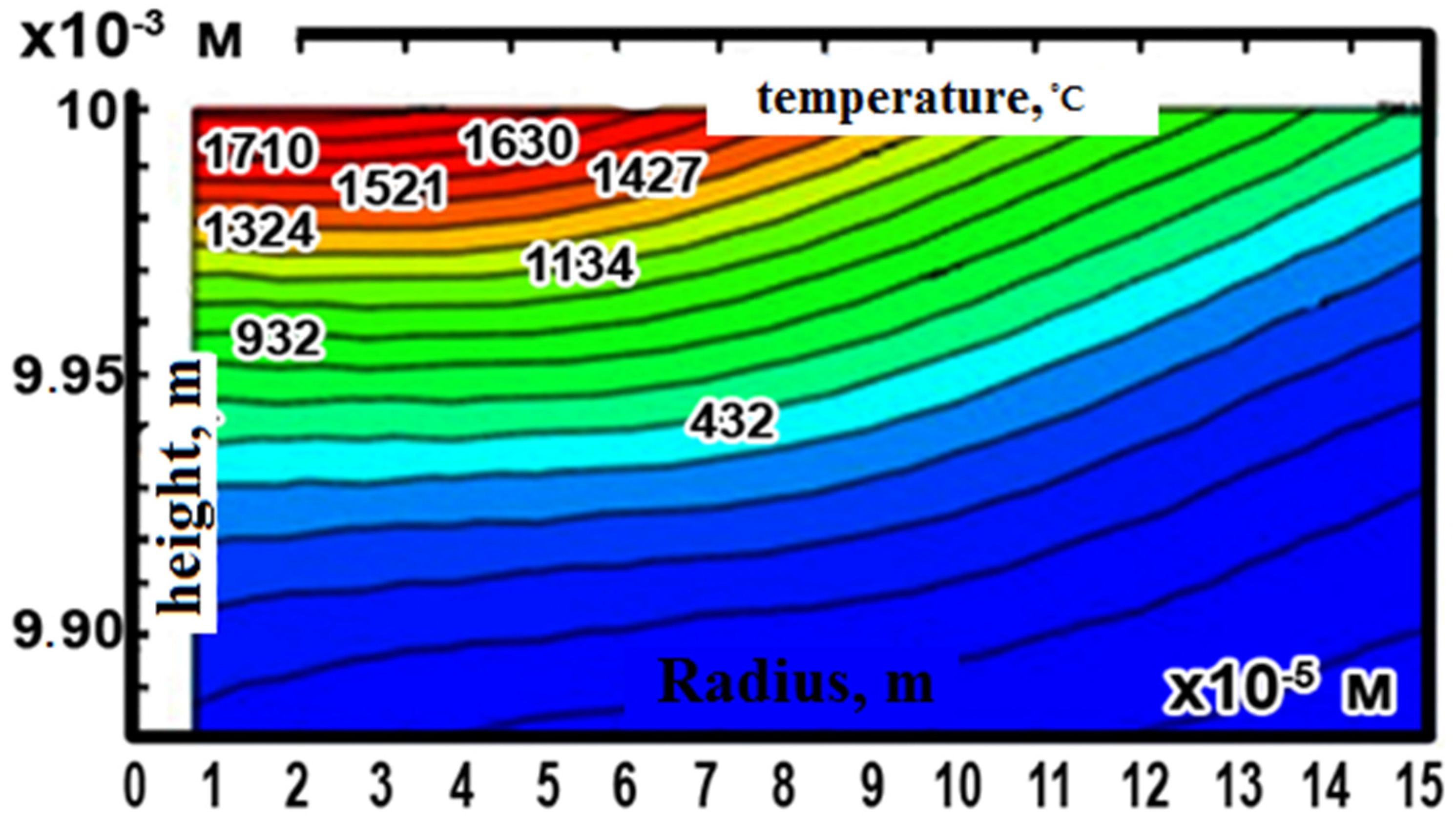
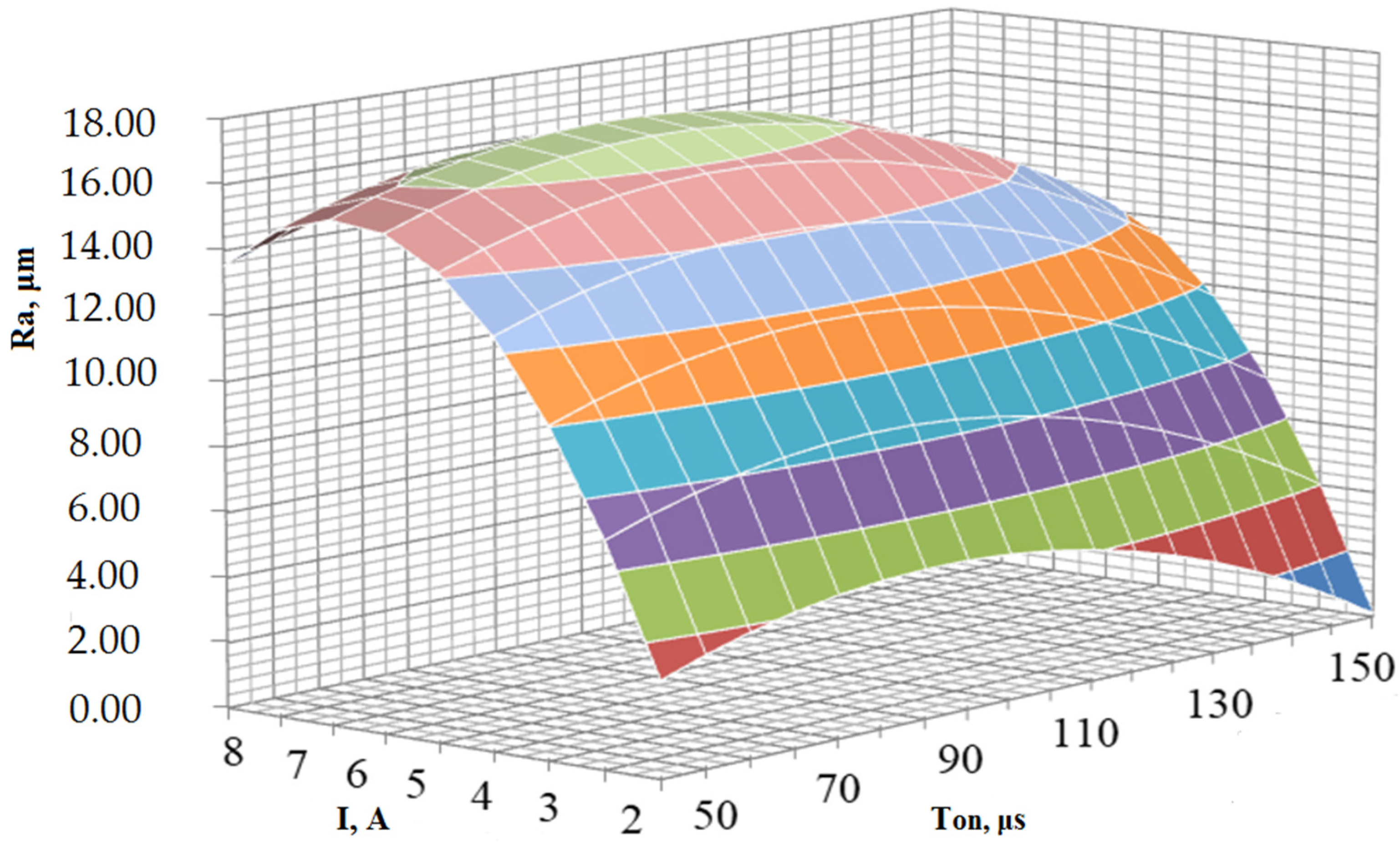
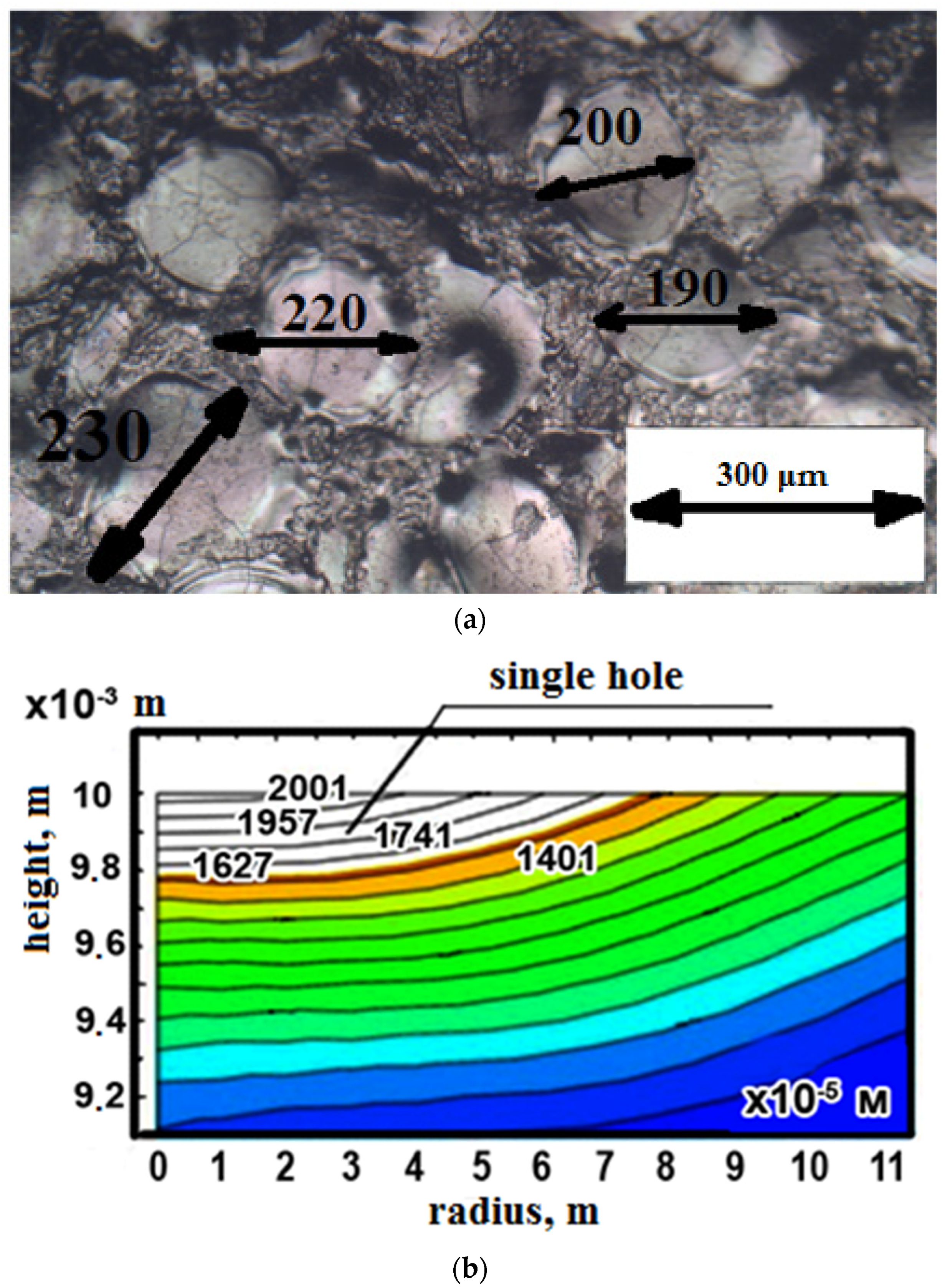
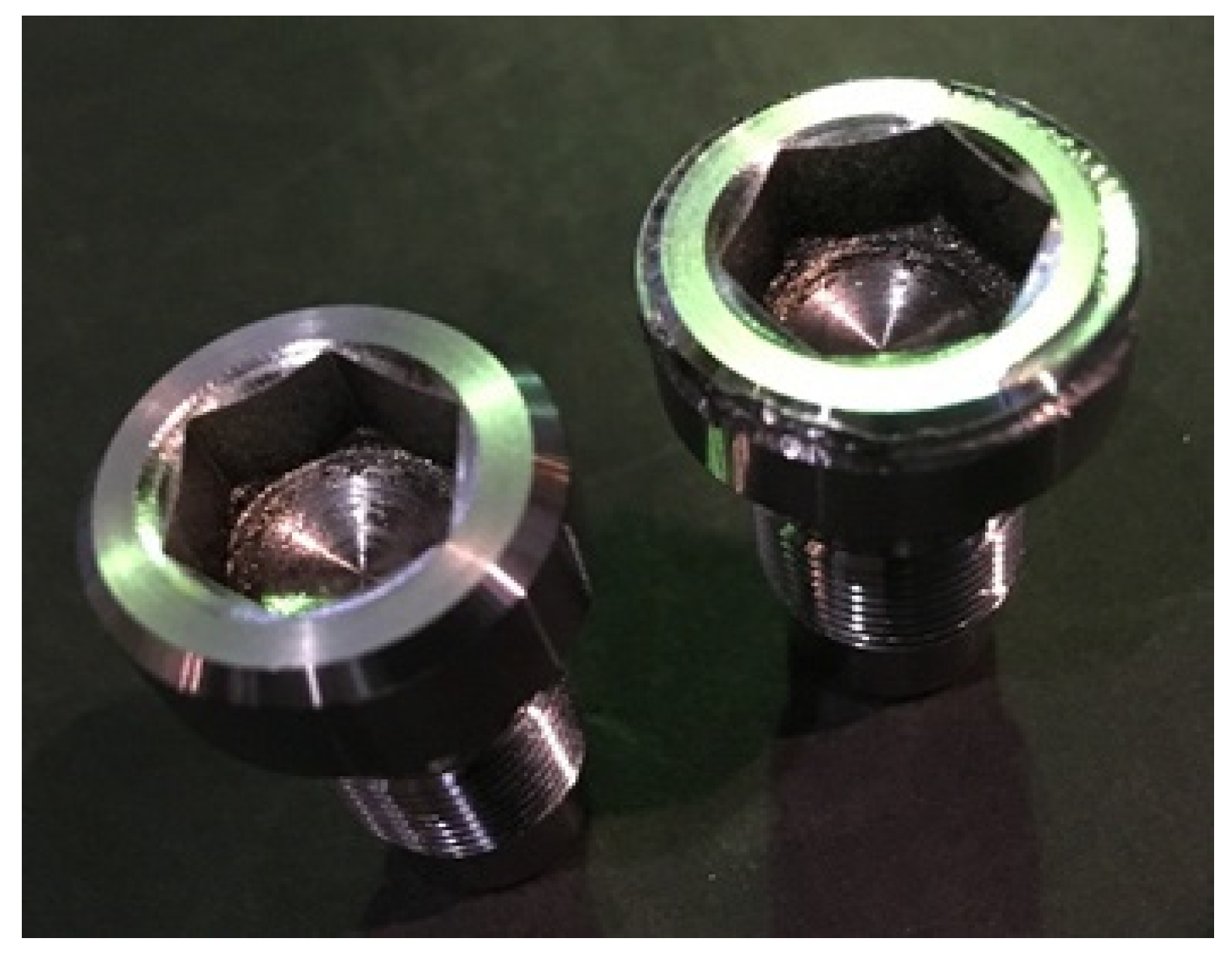
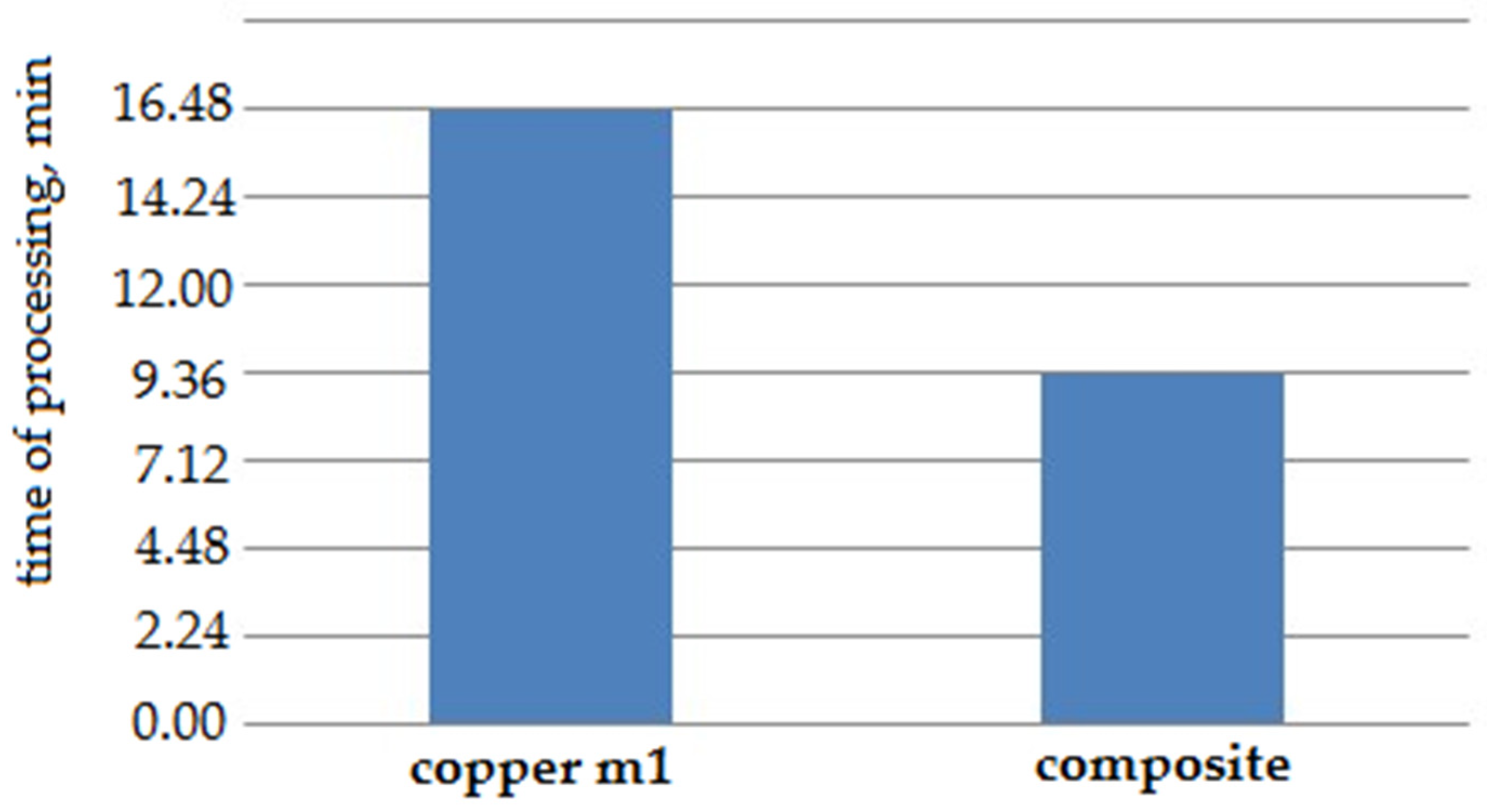
| P/p No. | Parameter | Designation | The quantity | Dimension |
|---|---|---|---|---|
| 1 | Heat capacity | Wed | 460 | j/(kg * °C) |
| 2 | Density | ρ | 7820 | kg/m |
| 3 | Coef.of thermal conductivity | k | 44 | wt/(m * °C) |
| 4 | Melting temperature | TPL | 1550 | °C |
| 5 | Boiling temperature | Tkip | 2900 | °C |
| Parameters Coded Values | Actual Values of Coded Variables | ||||
|---|---|---|---|---|---|
| Min Value (X1) (−1) | Max Value (X2) (+1) | Med Value(X0) (0) | Axial Value (-α) (−1.215) | Axial Value (α) (+1.215) | |
| Current, I (A) | 2 | 8 | 5 | 1 | 9 |
| Pulseturn-on time, (µs) | 40 | 150 | 100 | 30 | 200 |
| Voltage, U (V) | 50 | 100 | 75 | 45 | 105 |
| No. | X1 (I, A) | X3 (U, V) | |
|---|---|---|---|
| 1 | 2 | 40 | 50 |
| 2 | 8 | 40 | 50 |
| 3 | 2 | 150 | 50 |
| 4 | 8 | 150 | 50 |
| 5 | 2 | 40 | 100 |
| 6 | 8 | 40 | 100 |
| 7 | 2 | 150 | 100 |
| 8 | 8 | 150 | 100 |
| 9 | 1 | 100 | 75 |
| 10 | 9 | 100 | 75 |
| 11 | 5 | 30 | 75 |
| 12 | 5 | 200 | 75 |
| 13 | 5 | 100 | 45 |
| 14 | 5 | 100 | 105 |
| 15 | 5 | 100 | 75 |
| No. | Results | |||||
|---|---|---|---|---|---|---|
| y1 | y2 | y3 | ||||
| 1 | 0.80 | 2.91 | 5.05 | 2.9200 | 4.515700 | 2.12502 |
| 2 | 10.46 | 13.91 | 7.04 | 10.4700 | 11.799300 | 3.43501 |
| 3 | 1.46 | 2.95 | 4.47 | 2.9600 | 2.265100 | 1.50502 |
| 4 | 13.48 | 6.96 | 10.19 | 10.2100 | 10.627900 | 3.26005 |
| 5 | 1.34 | 2.88 | 4.42 | 2.8800 | 2.371600 | 1.54000 |
| 6 | 13.96 | 7.14 | 10.52 | 10.5400 | 11.628400 | 3.41004 |
| 7 | 4.41 | 2.99 | 1.57 | 2.9900 | 2.016400 | 1.42000 |
| 8 | 14.88 | 11.01 | 7.14 | 11.0100 | 14.976900 | 3.87000 |
| 9 | 2.92 | 1.43 | 4.41 | 2.9200 | 2.220100 | 1.49000 |
| 10 | 12.43 | 8.38 | 16.50 | 12.4367 | 16.483633 | 4.06000 |
| 11 | 7.24 | 13.96 | 10.60 | 10.6000 | 11.289600 | 3.36000 |
| 12 | 7.35 | 10.65 | 13.95 | 10.6500 | 10.890000 | 3.30000 |
| 13 | 11.60 | 15.33 | 7.87 | 11.6000 | 13.912900 | 3.73000 |
| 14 | 15.57 | 7.67 | 11.62 | 11.6200 | 15.602500 | 3.95000 |
| 15 | 7.69 | 11.31 | 14.93 | 11.3100 | 13.104400 | 3.62000 |
| Regression Coefficient | Coefficient | Dispersion of Reproducibility | Student’s Criterion |
|---|---|---|---|
| b0 | 4.15040453 | 2.0373 | 4.0943 |
| b1 | 0.87471712 | 0.9353 | 4.1044 |
| b2 | 0.87471712 | 0.9353 | |
| b3 | 0.87471712 | 0.9353 | |
| b12 | 1.19753694 | 1.0943 | |
| b13 | 1.19753694 | 1.0943 | |
| b23 | 1.19753694 | 1.0943 | |
| b11 | 2.19660859 | 1.4821 | 2.2744 |
| b22 | 2.19660859 | 1.4821 | 0.9285 |
| b33 | 2.19660859 | 1.4821 |
| Experiment Number | EDM Modes | Average Value of Hole Diameters (μm) | ||
|---|---|---|---|---|
| I(A) | U(V) | |||
| 1 | 2 | 40 | 50 | 62.45 |
| 2 | 8 | 40 | 50 | 195.784 |
| 3 | 2 | 150 | 50 | 58.556 |
| 4 | 8 | 150 | 50 | 190.970 |
| 5 | 2 | 40 | 100 | 48.230 |
| 6 | 8 | 40 | 100 | 205.396 |
| 7 | 2 | 150 | 100 | 58.428 |
| 8 | 8 | 150 | 100 | 170.478 |
| 9 | 1 | 100 | 75 | 50.935 |
| 10 | 9 | 100 | 75 | 245.998 |
| 11 | 5 | 300 | 75 | 226.247 |
| 12 | 5 | 200 | 75 | 223.576 |
| 13 | 5 | 100 | 45 | 219.378 |
| 14 | 5 | 100 | 105 | 237.118 |
| 15 | 5 | 100 | 75 | 216.305 |
| Op. No. | Operation Name | Equipment | Brief Description of the Operation |
|---|---|---|---|
| 005 | Incoming control | Control of the workpiece parameters | |
| 010 | Detachable | MEBA 260AP | Cutting of billets from rolled products |
| 015 | Heat treatment | Heat treatment for hardness (45.5–50 HRC) | |
| 020 | Control | Hardness control | |
| 025 | CNC turning | HardingeGS150 | External geometry machining and threading |
| 030 | CNC turning | Hardinge GS150 | Outside geometry machining, face trimming, and hex hole drilling |
| 035 | Electrical discharge | 4E723 | Copy-piercing EDM machining of a 10 × 11.45 mm hexagon. |
| 040 | Locksmith | Locksmith stripping | |
| 045 | Control | Geometry control in accordance with design documentation |
| Processing Mode | I (A) | U (V) | |
|---|---|---|---|
| Rough | 9 | 200 | 80 |
| Finish | 3 | 200 | 80 |
Publisher’s Note: MDPI stays neutral with regard to jurisdictional claims in published maps and institutional affiliations. |
© 2021 by the authors. Licensee MDPI, Basel, Switzerland. This article is an open access article distributed under the terms and conditions of the Creative Commons Attribution (CC BY) license (https://creativecommons.org/licenses/by/4.0/).
Share and Cite
Ablyaz, T.R.; Shlykov, E.S.; Muratov, K.R. Improving the Efficiency of Electrical Discharge Machining of Special-Purpose Products with Composite Electrode Tools. Materials 2021, 14, 6105. https://doi.org/10.3390/ma14206105
Ablyaz TR, Shlykov ES, Muratov KR. Improving the Efficiency of Electrical Discharge Machining of Special-Purpose Products with Composite Electrode Tools. Materials. 2021; 14(20):6105. https://doi.org/10.3390/ma14206105
Chicago/Turabian StyleAblyaz, Timur Rizovich, Evgeny Sergeevich Shlykov, and Karim Ravilevich Muratov. 2021. "Improving the Efficiency of Electrical Discharge Machining of Special-Purpose Products with Composite Electrode Tools" Materials 14, no. 20: 6105. https://doi.org/10.3390/ma14206105





